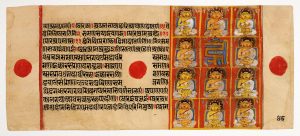14 Jainism
We begin looking at the Jain faith tradition with help from Nadini Balbir[1], from the British Library Sacred Texts website. If you would like to read the full text in the original, with illustrations, you would enjoy reading here:
An Introduction to the Jain Faith
“The Jain faith is one of the oldest faiths in India. Its presence is attested since the 6th–5th century BCE. This was the time when Mahavira preached in the eastern part of India, then known as Magadha. Since then the faith has been present on the Indian subcontinent, without any break. There is no way to historically pinpoint when it began; virtually no archaeological Jain ruins predate this time in India, but the earliest
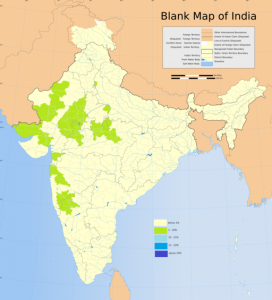
evidence there is suggests that Jainism was already a well-established faith. Today the Jains form a significant minority in Indian society, even though they make up hardly one percent of the total population, and have important diaspora communities in the UK, North America, Singapore, Belgium, etc.
Who do the Jains worship?
The Jain faith does not believe in a creator god like Hinduism or the Abrahamic faiths. In a way similar to Buddhists, the Jains venerate perfect ascetics who have been provided with valid authority on account of their career and abilities. They are named Jinas (‘Conquerors’) or Tirthaṃkaras (‘ford-makers’, because they have crossed to liberation) who provide ultimate models to the followers, the Jains. Mahavira was the twenty-fourth Jina. His predecessors are not historical figures, but this does not affect their place in respect and worship. Their existence lays emphasis on the idea of lineage which is at the center of Jainism. Mahavira is thus a continuator and a reformer rather than a founder, which he is often said to be.
An interesting perspective
What is a Jina?
All Jinas led similar lives. They were born as princes in royal families and withdrew from society in order to take up religious initiation, either before or after marriage, depending on the case.
The first stage of their ascetic life was full of tests that they had to overcome, showing their perseverance when faced with challenges. This spiritual evolution finally led to full enlightenment, known in Jainism as omniscience (kevalajñāna). When a Jina reaches this state they are then able to grasp everything everywhere whether it relates to past, present or future. They can then teach others the principles of the doctrine. This takes place during a general assembly where the Jina sits at the center, heard and seen by all beings wherever they are.
He then utters the divine sound which results in teaching expanded by him and his direct disciples, and builds around him a community of monks, nuns and lay followers. When his lifespan comes to an end and he has attained full perfection, the Jina leaves the human body for good and attains liberation from the cycle of rebirths.
What are the main features of the Jain worldview?
The Jain faith can be best labelled as a path to liberation or a path of purification. This is defined as consisting of correct faith, correct understanding and correct conduct. The Jain teaching in its multiple shapes is an expansion of these ‘three jewels’, the sequence of which is significant and emphasizes a concern for rationality as one leads to the other: one can have a proper conduct only if one is aware of the proper way to analyze what exists.
Correct faith means recognizing the existence of nine verities or principles.
They are:
- the fact that there are sentient souls or living beings (jīva)
- the fact that there are non-sentient or material things (ajīva) such as time or space
- the fact that karma flows in the soul (āsrava)
- the fact that once in the soul karma is attached to it (bandha)
- the fact that there are forms of activity that are good (puṇya)
- the fact that there are forms of activity that are bad (pāpa)
- the fact that flowing of karma should be blocked (saṃvara)
- the fact that karma that has flowed in should be annihilated (nirjarā)
- the fact that once all karmas have been eliminated final liberation from the cycle of rebirths takes place (mokṣa)
This systematic worldview forms the basis for the Jains way of life and their religious practices.
What is Karma ?
Example: Karma and how we create it
Most of us think of karma as something like “what goes around come around”. This is not quite so accurate, at least not for the Jains. Listen to this young man speak about his understanding of Karma and how it is created. We don’t WANT karma. That’s the point.
The literal meaning of the Sanskrit word Karma is deeds, including thoughts and words. However, according to Jainism, Karmas are thought to be invisible, and yet are fine particles of matter that exists all around us just like air particles. Our souls attract these karmas through activities involving mind, body and speech. This means every time we get annoyed, we attract karmas, every time we insult someone, we attract karmas, every time we lie or become steal or cheat, we attract karmas. These karmas form layers over our souls and keep us from realizing our true potential.
As the theory goes, the true nature of soul is clean, clear and full of knowledge. The karmas separate the soul from the truth and the soul goes through the cycles of birth and death.
The strength and duration of karmic bonds are very much dependent on the intensity of our intent. Our motives at the time of performing any act determines the strength and duration of the karma. Motive, intent, and purpose count in Jainism: two people performing similar activities could acquire karma quite differently. For example, a person killing an animal to eat, intentionally, is producing a karmic bond much stronger than a person killing insects unintentionally while walking or driving. Both involve an act of killing but the karma acquired will be different in these two situations.
Types of Karmas: From Harvard’s Jainism Literature Center
There are 8 different types of Karmas in Jain belief :
1.Knowledge-obscuring (Gyanavaraniya) Karma:
Gyan means knowledge. Varaniya means stoppage. This karma prevents the soul from acquiring true knowledge and keeps us ignorant just as a blindfold keeps us from seeing. How can we improve our lot unless we know what we are?
2. Perception-obscuring (Darshanavarniya) Karma:
Darshan means faith or perception. This karma prevents us from having a rational, common-sense approach towards our lives and surroundings.
3. Feeling-producing (Vedaniya) Karma:
This karma makes us experience either the sweetness of physical happiness or the bitterness of misery.
4. Deluding (Mohaneeya) Karma:
This karma, like too much alcohol, confuses all the human faculties and makes us forget what is right and what is wrong. It makes the souls bewildered and perplexed.
5. Life-span-determining (Ayu) Karma:
This karma determines the life spans of all living beings.
6. Physique-determining (Nam) Karma:
This karma determines the looks, skin, form etc. of the bodies of living beings.
7. Status-determining (Gotra) Karma:
This karma determines the family and status of our birth.
8. Obstructing (Antaraya) Karma:
This karma prevents us from doing a good deed or undoing a bad action when there is a desire to do it. For example, we may want to give donation to a charity but this karma might put obstacles in our path and stop us from doing so.
The Jain faith in practice
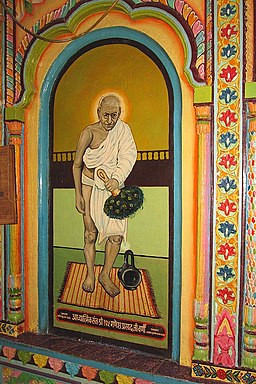
Since the beginning, the Jain society has taken account of the fact there are two ways of life, a stricter one for ascetics and a milder one for non-ascetics, who live in the world engaged in professional and family life and are often called lay followers. Male and female mendicants, on the one hand, male and female lay followers, on the other hand, form the fourfold Jain community.
Monastic life is regarded as an ideal aim but Jainism has devised a lot of possibilities for lay people to live their faith earnestly in daily practice.
Jain mendicants are people who have become monks or nuns after the official initiation ceremony called dīkṣā. They renounce ordinary life, receive a new name and the monastic equipment in accordance with the monastic order to which they will belong. Then they lead a life of itinerancy, walking long distances and not using any mode of transportation as a general rule.
They conform to the ‘five great vows’ (mahāvratas) which provide a broad frame of behaviour.
- Non-violence (ahiṃsā)
- Truth (satya)
- Not taking what has not been given (asteya)
- Celibacy (brahmacarya)
- Non-attachment or non-possession (aparigraha)
Necessary adjustments (aṇuvratas) are made to some of the same vows for lay followers. For instance, the mendicant ideal is complete celibacy, the lay ideal is satisfaction with one’s own partner. Jain mendicants practice non-attachment through a nomadic lifestyle, depending entirely on the lay followers for subsistence.
Lay followers are engaged in economic life and earn money, so in their case non-possession often means extensive charity in the form of donations to the temples. Such is the broad frame in which Jain mendicants and lay followers live. But there is a wide range of practices that strengthen the main concepts of the faith.
Non-violence and its manifestations
The foundational Jain principle of non-violence is the consequence of an in-depth

analysis of the Jain classification of life forms. These are based on the number of sense-faculties life forms possess, ranging from one to five, and apply to all living organisms, be them human, animal, plant or microbe. The most visible expression of this principle is the strict practice of vegetarianism, a key expression of Jain faith. Besides not consuming meat and fish, dietary restrictions extend to root vegetables such as onions, garlic, potatoes, fruits with a large number of seeds, alcohol (as fermentation means destroying minute life-forms), eggs and honey. Another aspect of food in religious life is the offering of alms to the mendicant, which is ritualized and obeys very strict rules. For mendicants as well as for lay people, fasting is one of the most common practices.
Jain faith puts a lot of emphasis on respect and worship to the religious teachers, from the ordinary mendicant up to the Jinas.
This is expressed in the daily prayer known as the ‘Fivefold homage’ (Navakāramantra or Pañcanamaskāra) which is a chanting of mantras or recitations, and is endowed with protective values. It is a key component of Jain worship, similar to the three refuges for the Buddhists or the Gāyatrīmantra for Hindus.
Fivefold Homage: Namaskāra-mantra
The Namaskāra-mantra is the fundamental prayer of the Jains. It pays homage to the five types of holy beings:
- arhat – enlightened teacher
- siddha – liberated soul
- ācārya – mendicant leader
- upādhyāya – preceptor or teacher
- sādhu – mendicant
Note that this is not praying for something material, asking for something, or otherwise encountering the divine. It is a recognition of these people and their role in human lives.
Other important religious acts include mantras for confession and repentance, meditating on key topics (anuprekṣā) such as impermanence, impurity of the body, etc., singing praises to the Jinas, worshipping Jina images in the temples, remembering important dates in the Jinas’ lives through festivals or pilgrimage to Jain sacred places.
Do all Jains believe the same thing?
With such a long and vital history it is to be expected that Jains have not always agreed on everything and that these differences in belief or practice resulted in divisions. However, divisions are based on practices, rather than doctrines, and all Jains agree on the foundational principles of karma and ahiṃsā.
The oldest division goes back to around the 1st century CE and remains the most important today. It produced the separation between the Śvetāmbaras and the Digambaras who hold various differences, the Digambaras being more strict in their practices and beliefs.
Who, or what, is the Jain source of authority?
The Jains do not believe in any god as creator of the universe or in any divine source of revelation who teaches humanity how to think and behave. For them the only
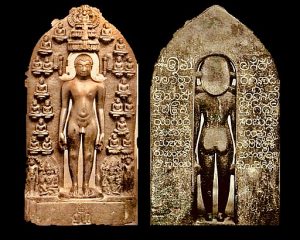
source of wisdom and authority are the Jinas. These royal-born human beings renounced their royal destiny in their youth, took to asceticism and slowly became all-knowers. As a consequence they emit the ‘divine sound’ (divyadhvani) which is the ultimate source of all teaching and is understood by every being in his own language. There are twenty-four Jinas but the last one, Mahavira, is regarded by the Jains as the source of their body of doctrine. In Mahavira’s time (5th–6th century BCE) the teaching was transmitted orally to his chief disciples (the gaṇadharas), who taught their own disciples, etc.
This mode of transmission remained prevalent for several centuries, but, as tradition puts it, with the passing of time knowledge was forgotten bit by bit. For example, all Jains agree that the Earlier texts (the Purvas), considered to go back to the Jina’s direct disciples, are long since lost. The last person who mastered them was Bhadrabahu who died around 350 BCE.
What is the Jain canon of scripture?
It is important to bear in mind that the teaching of the Jains is not associated with a single book but disseminated over the various texts described, which are often labelled as ‘canonical’. This term, however, is increasingly felt inadequate because it implies a fixed body of texts sanctioned by a central authority. Jains commonly use the words siddhānta and āgama, which are pan-Indian terms. The former term conveys the idea of validity and authority, and is perhaps more common among Digambaras. The latter term means ‘what has come down to us’ or tradition. In addition, the Jain scriptural tradition goes much beyond those put into writing in the first centuries of the Common Era. Jain mendicants in large number, and lay followers in a lesser degree, have contributed to transmission of the faith, and to Indian literatures, through rewritings, abridgments or new modes of presentation of earlier material.
Digambaras and Śvetāmbaras do not recognize the same body of scriptures as authoritative, however one should not conclude from this that they differ a lot on the fundamentals.
Digambaras
According to the Digambaras, a lot of teaching has been lost, but there were a few ascetics who could remember the essentials. One of them was Dharasena (ca. 137 CE) who transmitted them to his disciples, Puṣpadanta and Bhūtabali. They wrote the Teaching in six parts (Ṣaṭkhaṇḍāgama). Then another ascetic called Guṇabhadra
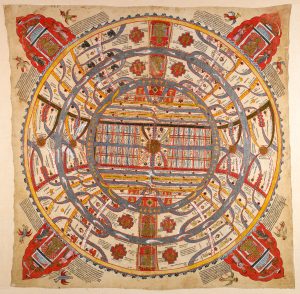
wrote a Treatise on passion (Kaṣāyaprābhṛta). These large and complex treatises form the first authoritative works for the Digambaras. They provide technical expositions on cosmology, karma theory and the way karmic matter attaches to the soul as a result of desire and passions.
Śvetāmbaras
According to the Śvetāmbaras, the teaching was collected and put to writing in its final redaction during a collective recitation which took place in Valabhī (Gujarat) around 450 CE. This was led by Devarddhigaṇi Kṣamāśramaṇa. The teaching was organised in a set of texts divided into various categories (Angas, Upāngas, Chedasūtras, Mūlasūtras, Prakīrṇakas). A junior monk or nun starts with the basic texts (Mūlasūtras) and in time progresses to read more technical texts as he becomes more senior. The texts are varied; they are made up of prose and verse, and take the form of philosophical dialogues, poetry depicting ascetic life or exhorting ascetics to follow the ideal mendicant’s way of life, legends or parables, hymns to Mahavira and lists of concepts.
Within the scriptures, some groups of texts are unchanging while others show fluidity and divergences. The number of accepted scriptures among Śvetāmbaras corresponds to a sectarian division that took shape from the 15th century onwards. Mūrtipūjaks consider there to be forty-five scriptures while Sthānakavāsins and Terāpanthins state there are thirty-two.
In Mahavira’s time the prevalent sacred language was Sanskrit. It was associated with the Vedas, the earliest sacred texts of Hinduism, and with the brahmins, the religious elite in charge of their transmission. In contrast, Mahavira, like the Buddha, did not use Sanskrit as a preaching language, but Prakrit.
Contents and forms of the teaching
Jain teaching was thus fixed into writing in the middle of the 5th century CE, at the latest. It was available first in the form of hand-written manuscripts. Those which have come down to us, however, are not older than the end of the 11th century. Nothing before this time could be preserved due to the Indian climatic conditions. In
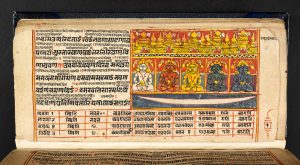
Northern India, manuscripts of Jain texts were first copied on palm-leaf and, from the 14th century onwards, on locally made paper. They were produced in large numbers in India and started entering European libraries in the last decades of the 19th century. The then India Office Library and British Museum were among the main institutions with collections of Jain manuscripts. The richness of Jain manuscript culture is a sign of the importance attached to scriptural knowledge (known as śrutajñāna) in this faith: knowledge being one of the three requisites for spiritual progress.
The fundamentals analyzed in canonical scriptures of both Jain groups are retold through concise definitions in That Which Is (Tattvārthasūtra), a Sanskrit handbook that has a special place in Jain tradition because it transcends the boundary between Digambaras and Śvetāmbaras and is recognized by both of them.
Example of Jain Storytelling
On February 18th and 19th, 2012, dancer and storyteller Pranita Jain from Kalapriya Center for the Indian Performing Arts, led a special interactive storytelling demonstration animating tales of King Vikramaditya with mudras (gestures) and facial expressions at the Asian Art Museum.
Story-telling has always been considered a crucial medium of teaching by the Jains. Mahavira’s career and the legendary lives of the other Jinas are the first source of stories. They form an essential part of one canonical scripture, the Kalpasūtra. Its text has often been accompanied by gorgeous paintings in manuscripts.
Example
View the beautiful Samgrahaniratna at the British Library:
Several books of the Śvetāmbara canon show the doctrine in acts through the eventful lives of good and bad characters who illustrate the working of the karma-theory and the circulation of souls up and down the three worlds. The Uttarādhyayanasūtra, a Śvetāmbara canonical scripture memorized and studied by new ascetics at the beginning of their religious lives, combines didactic chapters with legends, providing rich material for willing painters of manuscripts.
A broad repertoire of heroes and heroines is thus produced, and enlarged over the centuries through rewritings in all the languages used by the Jains and all the poetic forms evolved in Medieval and modern times. The British Library manuscript of the Story of the Sunday’s Vow is an instance of a text in Old Hindi produced among the Digambaras in the 17th century. The language, the poetic form and the pictorial style, all illustrate how the Jain tradition has been able to adjust to new means in order to hand down the key-values of its faith and satisfy new audiences.
Scripture-worship
Not only do the Jains respect the contents of sacred texts. They also venerate them as holy objects in themselves. Scriptures are sometimes found in temples in the shape of books, symbols or quotations inscribed on the walls. In addition, the Digambara Teaching in Six Parts is housed in a temple in Mudbidri, Karnataka. For a long time it was worshipped without being studied. It became available to study only in the 1930s. On the Śvetāmbara side, since at least the 14th century, the Kalpasūtra has been used during the yearly Jain festival of Paryushan (August–September), with parts of it being read in temples and manuscripts (or now printed books) being displayed ceremoniously during processions. Both Śvetāmbaras and Digambaras have a festival in honor of scriptural knowledge which is the occasion to clean and restore manuscripts or books and to worship then as embodiments of knowledge.
Summary
The Jain faith’s primary concern is to purify and liberate the soul from the perpetual cycle of death and rebirth. The Jinas, practicing meditation and conforming to fundamental vows such as non-violence and truthfulness, have overcome attachment and desire and set the supreme example for all Jain followers. The path to liberation is defined by three main principles, the so-called three jewels of Jainism: right faith, right understanding and right conduct.
National Geographic Society. “Jainism.” National Geographic Society, 19 Aug. 2020, www.nationalgeographic.org/encyclopedia/jainism/#:~:text=Jainism%20teaches%20that%20the%20path,is%20determined%20by%20one’s%20karma.
Balbir, Nalini. “An Introduction to the Jain Faith.” The British Library: Sacred Texts, The British Library, 12 Nov. 2018, www.bl.uk/sacred-texts/articles/an-introduction-to-the-jain-faith.
“The Jain Universe Online.” JAINpedia > Home, 2021, www.jainpedia.org/.
Vora, Anop R. “Jainism Resource Center – Theory of Karma.” Jainism Resource Center – Articles, Harvard Jainism Literature Center, 2021, sites.fas.harvard.edu/~pluralsm/affiliates/jainism/article/karma.htm.
Arora, Mahir. “Karma and How We Create It.” TED, 2019, www.ted.com/talks/mahir_arora_karma_and_how_we_create_it.
“Indian Storytelling and Dance with Pranita Jain.” Asian Art Museum of San Francisco, 13 Mar. 2012, youtu.be/YvnBUpjvWGw.
- Nalini Balbir is a Professor of Indology at Sorbonne Nouvelle University Paris, where she teaches Sanskrit. She has specialized in research on various aspects of the Jain tradition. Her publications include a Catalogue of the British Library Jain manuscripts (2006, with co-authors K V Sheth, K K Sheth and C B Tripathi). She has also contributed to the JAINpedia website which includes digitized Jain manuscripts from various London collections. ↵

